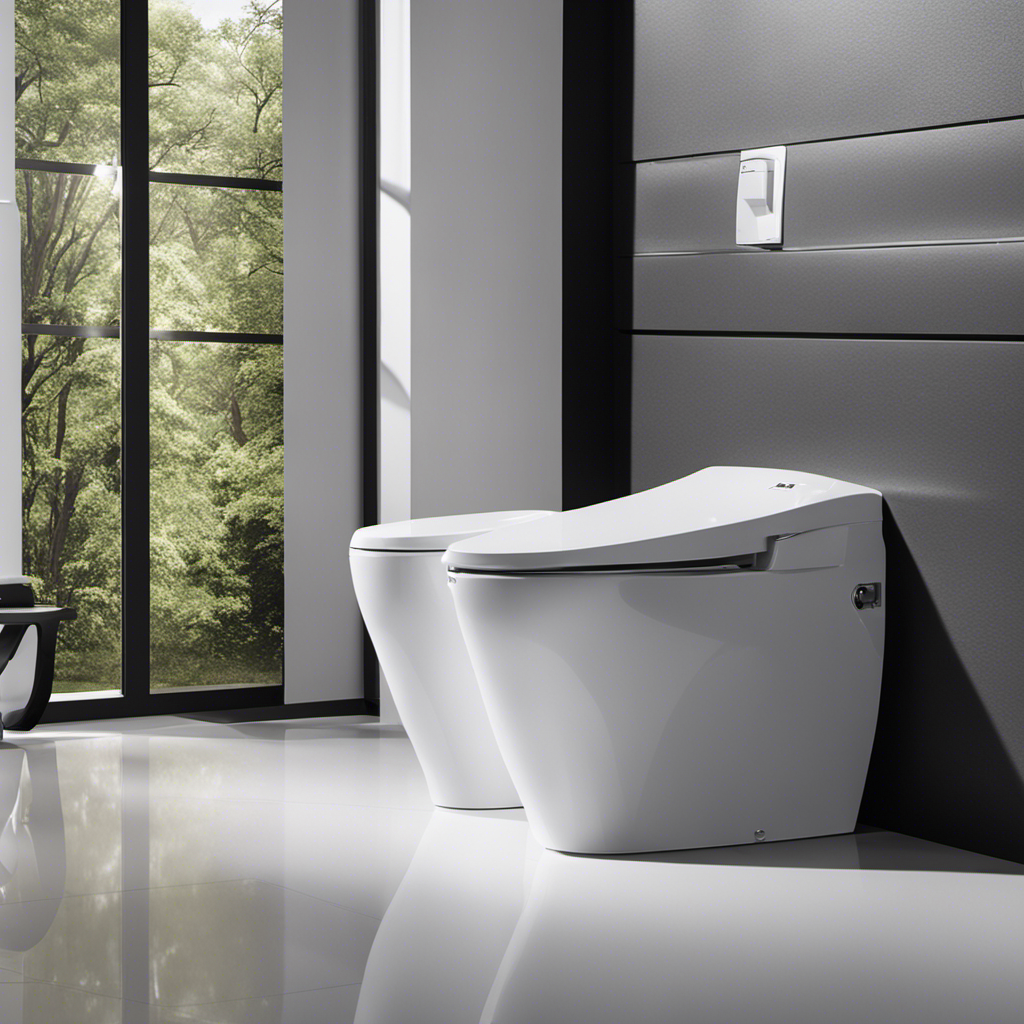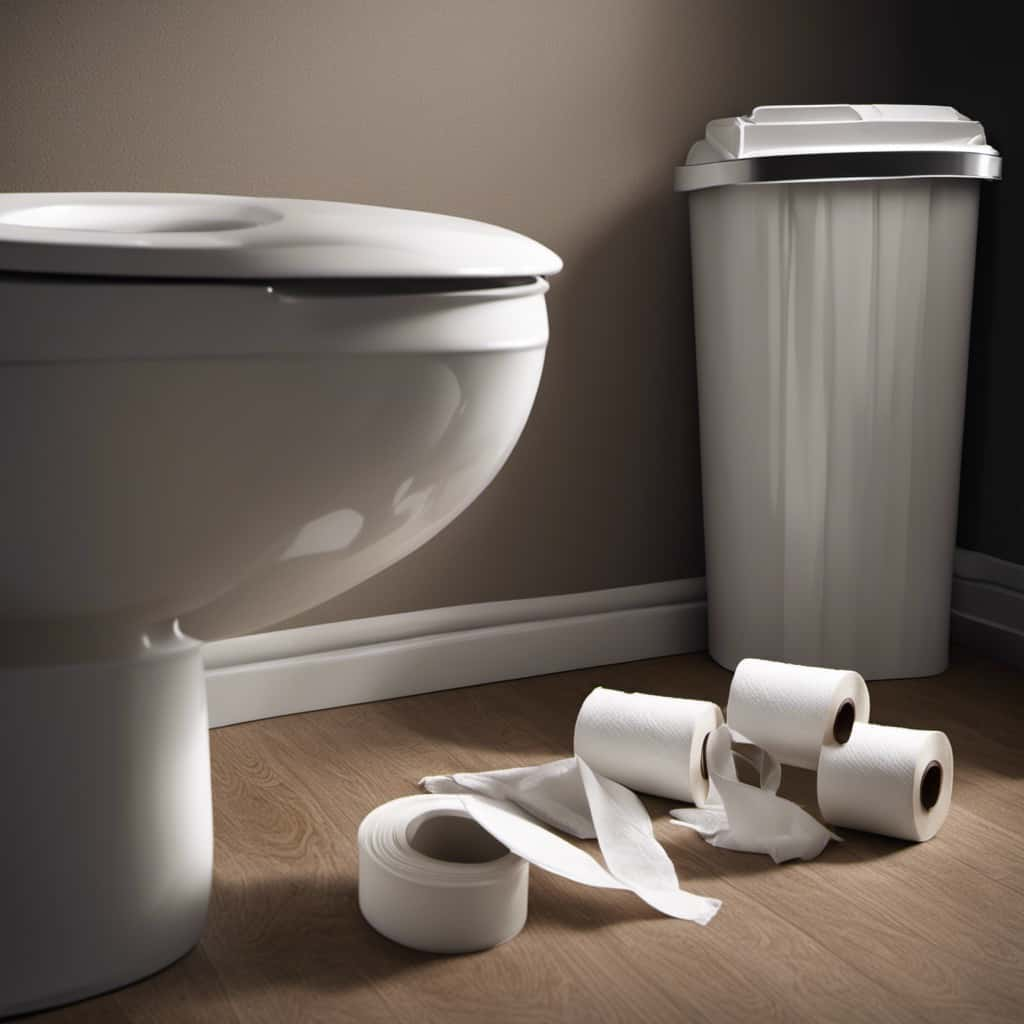So here I am, sitting in the dark, contemplating the mysteries of flushing a toilet without electricity.
It’s a situation we all dread, but one that we may find ourselves in at some point. How many times can you flush a toilet without power? Well, that’s what we’re here to find out.
In this article, we’ll explore the factors affecting flushes without power, the water efficiency of toilets, and share some tips for conserving water during those dreaded power outages.
So, let’s dive in and unravel this important bathroom conundrum.
Key Takeaways
- Factors affecting the number of flushes without power include toilet water efficiency, fill valve and flush valve, size and shape of the toilet bowl, water pressure, and availability of water supply.
- Water-saving techniques and eco-friendly flush systems such as dual-flush toilets, low-flow toilets, pressure-assisted toilets, and gravity-assisted toilets can help conserve water during power outages.
- The average number of flushes without power depends on various factors such as toilet tank capacity, water pressure, water level in the bowl, flushing mechanism, and water availability.
- Tips for conserving water during power outages include limiting toilet flushing to essential needs, using a bucket of water for manual flushing, collecting and reusing water from the shower, and considering portable camping toilets or emergency toilet options.
Factors Affecting Flushes Without Power
To maximize the number of flushes without power, you’ll need to consider various factors.
One of the most important factors affecting flushes is the toilet water efficiency. The efficiency of a toilet depends on the amount of water it uses per flush. Older toilets typically use more water, while newer models are designed to be more water-efficient.
Another factor to consider is the fill valve and flush valve of the toilet. These valves control the flow of water during a flush and can affect the number of flushes you can get without power.
Additionally, the size and shape of the toilet bowl can also impact the number of flushes. A larger bowl may require more water to effectively flush waste.
Water Efficiency of Toilet Flushes
You can maximize the amount of water your toilet flushes by using a more efficient model. Here are some water-saving techniques and eco-friendly flush systems that can help you reduce water usage:
-
Dual-flush toilets: These toilets have two buttons or handles, allowing you to choose a full flush or a half flush, depending on the waste.
-
Low-flow toilets: These toilets use less water per flush compared to traditional models, without compromising flushing performance.
-
Pressure-assisted toilets: These toilets use pressurized air to enhance flushing power, reducing the amount of water needed for an effective flush.
-
Gravity-assisted toilets: These toilets rely on the force of gravity to create a powerful flush, using less water and energy.
By incorporating these water-saving techniques and using eco-friendly flush systems, you can significantly reduce your water consumption and contribute to environmental conservation.
Now let’s explore the average number of flushes without power.
Average Number of Flushes Without Power
During a power outage, it’s important to consider the average number of flushes that can be made without electricity. Factors affecting water efficiency play a significant role in determining the number of flushes possible. To provide you with an understanding of this, I have prepared a table showcasing the average number of flushes based on different factors. This table will help you plan and prepare for emergencies, ensuring you have enough water for essential needs. Understanding these factors can help you conserve water and be better prepared during power outages. Now, let’s move on to the next section where I will provide you with tips for conserving water during power outages.
| Factor | Average Number of Flushes |
|---|---|
| Toilet Tank Capacity | 3-5 Flushes |
| Water Pressure | 2-3 Flushes |
| Water Level in the Bowl | 1-2 Flushes |
| Flushing Mechanism | 1-3 Flushes |
| Water Availability | Varies |
Tips for Conserving Water During Power Outages
Water conservation is essential during power outages, so here are some tips to help conserve water:
-
Limit toilet flushing: Only flush when absolutely necessary. Each flush uses about 1.6 gallons of water, so conserving flushes can save a significant amount of water.
-
Use a bucket: Instead of flushing, pour a bucket of water into the toilet bowl to manually flush waste. This uses less water than a regular flush.
-
Collect and reuse water: Place a bucket in your shower to collect water while you wait for it to warm up. This water can be used for flushing or other non-potable purposes.
-
Utilize emergency toilet options: Consider using a portable camping toilet or a bucket with a plastic bag and absorbent material as a temporary emergency toilet.
Alternative Toilet Flushing Methods
When it comes to alternative toilet flushing methods, there are a few options to consider.
One option is to use a bucket and water to manually flush the toilet. This involves pouring a sufficient amount of water into the toilet bowl to create the necessary force to flush waste away.
Another option is to utilize gravity flush options, such as composting toilets or dry flush toilets, which rely on the natural force of gravity to remove waste.
Additionally, portable camping toilets can be a convenient solution for situations where traditional flushing toilets are not available. These toilets are designed to be compact, lightweight, and easy to transport, making them ideal for outdoor activities or temporary use.
Bucket and Water
You can use a bucket of water to flush a toilet multiple times without power. Here’s how:
-
Alternative bucket options:
- Choose a sturdy bucket with a handle for easy transportation.
- Look for a bucket with a lid to prevent spills and odors.
- Consider using a smaller bucket if a larger one is not available.
-
Water storage:
- Fill the bucket with water from a nearby source, such as a bathtub or rain barrel.
- Store additional water in containers for future use.
- Ensure the water is clean and free from debris.
-
Flushing technique:
- Pour the water from the bucket into the toilet bowl.
- Aim for the center of the bowl to maximize the flushing effect.
- Repeat the process as needed until the toilet is adequately flushed.
Using these alternative bucket options and proper water storage techniques, you can maintain basic sanitation during a power outage.
Gravity Flush Options
In addition to using a bucket and water, there are other gravity flush options that can be utilized when there is no power to operate the toilet. These options rely on the natural force of gravity to create water pressure and initiate the flushing process.
One such option is the siphon action toilet. This type of toilet uses a combination of gravity and a siphon mechanism to create a powerful flush. When the flush lever is pressed, water is released from the tank into the bowl, creating a sudden surge of water pressure. This surge then activates the siphon action, which pulls the waste and water out of the bowl and into the drainpipe.
The siphon action toilet is a popular choice for areas with unreliable power supply or off-grid living situations. It offers a reliable and efficient flushing method without the need for electricity or external power sources.
Portable Camping Toilets
If you’re camping and need a convenient solution for bathroom needs, portable camping toilets are a great option. These toilets provide a hygienic and comfortable experience even in the great outdoors. Here are four key benefits of portable camping toilets:
-
Portability: These toilets are designed to be lightweight and compact, making them easy to transport and set up wherever you go.
-
Composting capabilities: Portable composting toilets are an eco-friendly option that use natural processes to break down waste into compost. This eliminates the need for water and reduces environmental impact.
-
Chemical toilet options: Some portable camping toilets use chemicals to break down waste and control odor. These chemical toilets are easy to use and maintain, providing a clean and odor-free experience.
-
Convenience: Portable camping toilets offer the convenience of having a toilet nearby, eliminating the need to search for public restrooms or venture into the wilderness.
With portable camping toilets, you can enjoy the comforts of a bathroom even in remote locations.
Transitioning to the next section, let’s now discuss emergency preparedness for toilet usage.
Emergency Preparedness for Toilet Usage
When it comes to emergency preparedness for toilet usage, there are several key points to consider.
Firstly, alternative flushing methods can be used when there is no power available. These methods include using a bucket of water to manually flush the toilet or using a portable camping toilet.
Secondly, water conservation tips are crucial in emergency situations to ensure that the available water supply is used efficiently. This can involve limiting the amount of water used for flushing or exploring options such as using gray water for toilet flushing.
Lastly, it is important to have sanitation options in place that do not rely on power, such as composting toilets or chemical toilets, to maintain proper hygiene and sanitation during emergencies.
Alternative Flushing Methods
There’s a variety of alternative methods to flush a toilet without power. When faced with a power outage or emergency situation, it’s important to know these options.
Here are four ways to flush a toilet without power:
-
Gravity Flush: If you have a water-saving toilet, it can still flush using gravity. Fill a bucket with water and pour it into the bowl quickly. The force of the water should create enough pressure to flush.
-
Dual Flush Conversion Kit: Install a dual flush conversion kit on your toilet. These kits allow you to manually control the water flow, using less water for liquid waste and more for solid waste.
-
Composting Toilet: Consider installing a composting toilet. These systems use little to no water and convert waste into compost. They are eco-friendly and require minimal maintenance.
-
Portable Camping Toilet: In emergencies, a portable camping toilet can be used. These toilets come with waste bags that can be disposed of later.
Water Conservation Tips
Conserving water is crucial during a power outage, so consider using a bucket system to collect and reuse water for other purposes. This simple water-saving strategy can make a significant difference in reducing water usage during emergencies. In addition to the bucket system, there are several other water-saving strategies that can help you minimize water waste. Here are some tips to consider:
| Water Saving Strategies | Reducing Water Usage |
|---|---|
| Fixing leaky faucets and pipes | Taking shorter showers |
| Installing low-flow showerheads and faucets | Using a broom instead of a hose to clean outdoor areas |
| Collecting rainwater for gardening | Only running the dishwasher and washing machine with full loads |
| Watering plants in the early morning or late evening to reduce evaporation | Using a spray nozzle with a shut-off valve when washing your car |
Sanitation Options Without Power
Using a bucket system for collecting and reusing water is an effective way to maintain sanitation during a power outage. When faced with a lack of electricity, it is important to consider alternative methods for maintaining proper hygiene.
Here are four sanitation alternatives and emergency toilet solutions that can be implemented during such situations:
-
Bucket System: Fill a bucket with water and place it in the bathroom for flushing the toilet. Pour a generous amount of water into the bowl to create enough force to flush waste down the drain.
-
Composting Toilet: Consider installing a composting toilet that uses little to no water. These toilets break down waste into compost, reducing the need for water and promoting sustainability.
-
Portable Camping Toilet: A portable camping toilet can be a great option during a power outage. These toilets are self-contained and can be easily emptied and cleaned.
-
Chemical Toilet: Chemical toilets use chemicals to break down waste and neutralize odors. They are commonly used in RVs and boats, but can also be utilized in emergency situations.
Frequently Asked Questions
What Are the Factors That Can Affect the Number of Flushes a Toilet Can Handle Without Power?
Factors affecting toilet flushes without power include water volume, toilet design, and blockages. Water consumption impacts toilet efficiency; low-flow toilets require less water per flush. Blockages can reduce the number of flushes a toilet can handle.
How Efficient Are Toilet Flushes in Terms of Water Consumption?
Toilet flush efficiency is crucial in conserving water, especially during power outages. Water-saving techniques, such as dual-flush toilets and low-flow fixtures, help reduce consumption. Implementing these strategies ensures efficient water usage and minimizes environmental impact.
On Average, How Many Flushes Can a Toilet Handle During a Power Outage?
During a power outage, a toilet’s functionality is affected as it relies on electricity to power the flushing mechanism. In such situations, alternatives to flushing the toilet include using a bucket of water or portable camping toilets.
Do You Have Any Tips for Conserving Water During Power Outages?
During power outages, it is important to conserve water. Here are some tips: limit flushing to only when necessary, use hand sanitizer instead of washing hands, and store water in clean containers for emergencies.
Are There Alternative Methods to Flush a Toilet When There Is No Power Available?
There are alternative solutions for flushing a toilet when there is no power available. One option is to create a DIY toilet flush using a bucket of water and pouring it into the bowl.
Conclusion
In conclusion, when it comes to flushing a toilet without power, several factors come into play. The water efficiency of the toilet, the amount of water in the tank, and the type of flush mechanism all affect the number of flushes possible.
On average, a toilet can be flushed 5-7 times without power, but this can vary. To conserve water during outages, consider using alternative methods like pouring water into the bowl or using a bucket.
Overall, being prepared for emergencies is essential. Just like having a backup generator is as crucial as having a spare tire in case of a flat.










